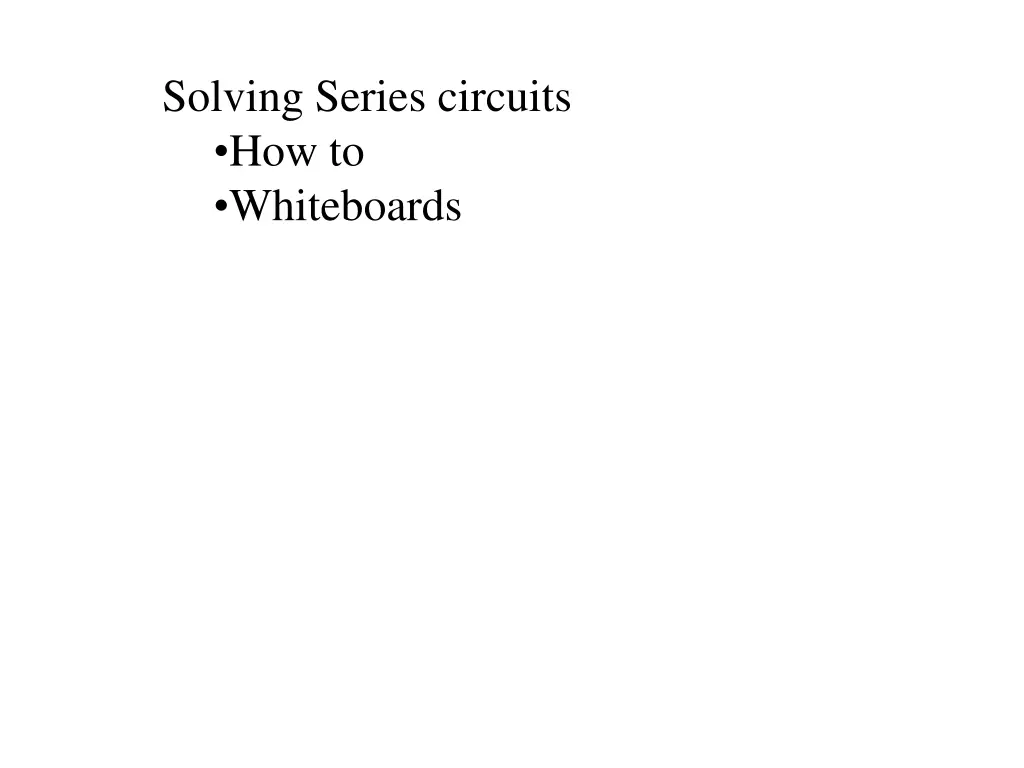
Understanding Series Circuits and Resistor Calculations
Dive into the world of series circuits with our comprehensive guide on solving circuit equations, calculating total resistance, voltage drops, and current readings using Ohm's Law. Enhance your knowledge of electrical circuits with explanations, analogies, whiteboard illustrations, and step-by-step solutions to circuit problems.
Download Presentation

Please find below an Image/Link to download the presentation.
The content on the website is provided AS IS for your information and personal use only. It may not be sold, licensed, or shared on other websites without obtaining consent from the author. If you encounter any issues during the download, it is possible that the publisher has removed the file from their server.
You are allowed to download the files provided on this website for personal or commercial use, subject to the condition that they are used lawfully. All files are the property of their respective owners.
The content on the website is provided AS IS for your information and personal use only. It may not be sold, licensed, or shared on other websites without obtaining consent from the author.
E N D
Presentation Transcript
Solving Series circuits How to Whiteboards
A Series Circuit has many voltages, but only one current A1 Note that the total voltage drops add to source voltage 1 V1 = IR = (3 A)(1 ) = 3 V V1 24 V V2 = IR = (3 A)(2 ) = 6 V 2 V2 A2 V3 = IR = (3 A)(5 ) = 15 V 5 V3 A3 How to solve series: 1. Find the total resistance (1 + 2 + 5 = 8 ) 2. Find the one current (I = V/R = (24 V)/(8 ) = 3 A - all the ammeters read 3 A) 3. Use V = IR to find voltages (voltage drops)
I A1 A2 R1 R2 R3 Analogy - ping pong balls - electrons All start moving at once/speed of impulse, speed of particles Resistance anywhere along the tube limits flow everywhere
Whiteboards 1 | 2 | 3 | 4
What is the Total resistance? 11 7 5 20.0 V R tot = R1 + R2 + R3 ... = 5 + 7 + 11 = 23 23
What is the reading on both ammeters? (The one current) (answer with 3 SF) 11 5 7 A2 A1 20 V I = V/R = (20 V)/(23 ) = .8696 = .870 A .870 A
What do the voltmeters read? (3 SF) V1 V2 11 7 5 20.0 V V = IR V1 = (5 )(.8696 A) = 4.35 V V2 = (18 )(.8696 A) = 15.7 V 4.35 V, 15.7 V
What do the voltmeters read? (3 SF) V1 V2 11 9 5 13 3 35 V R = 41 , I = .8537 A V = IR V1 = (5 )(.8537 A) = 4.27 V V2 = (20 )(.8537 A) = 17.1 V V3 = (13 )(.8537 A) = 11.1 V V3 4.27 V, 17.1 V, 11.1 V
What do the voltmeters read? (3 SF) V1 V2 200 90 500 110 V3 130 120 V R = 1030 , I = .1165 A V = IR V1 = (500 )(.1165 A) = 58.3 V V2 = (90 )(.1165 A) = 10.5 V V3 = (330 )(.1165 A) = 38.4 V 58.3 V, 10.5 V, 38.4 V
What is the value of the mystery resistor if V1 reads 3.17 V (3 SF) V1 ??? 7 5 20 V I = V/R = (3.17 V)/(5 )= .634 A Rtot = V/I = (20 V)/(.634 A) = 31.55 Rtot = 5 + 7 + ?? = 31.55 ?? = 19.5 19.5
V3 A3
